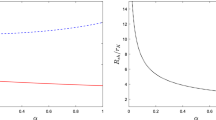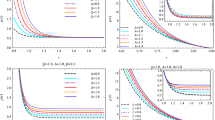Abstract
We study the evolution of some simple cosmological black holes in the framework of the generalized Lemaitre-Tolman-Bondi (LTB) model developed by Lasky and Lun, which includes the effects of nonzero pressure. A small Gaussian overdensity is introduced into the LTB solutions, and an equation of state is assumed in order to fix the relation between the pressure and the density. Numerical solutions are calculated, which simulate the dynamical effects of the pressure field on the formation of a black hole as the end state of the collapse. The influence of the pressure effects on the behavior of the solutions is measured by comparing the development of the generalized LTB model with that of the corresponding pressure-free LTB model. Finally, we plot the location of the apparent horizon on each shell and examine the differences in the locations between the cases with and without pressure. The evidence indicates that the apparent horizon forms later in the presence of pressure.












Similar content being viewed by others
References
S W Hawking and G F R Ellis The large scale structure of space-time (Cambridge: Cambridge University Press) Chapter 9, p 299 (1973)
L Bergström and A Goobar Cosmology and Particle Astrophysics, 2nd edn. (Springer) Chapter 4, p 61 (2006)
G F R Ellis and H van Elst Cosmological models: Cargese lectures 1998 NATO Sci. In Ser. C. 541(1) (1999)
J R Oppenheimer and H Snyder Phys. Rev. 56 455 (1939).
G Lemaitre Ann. Soc. Sci. Bruxelles A 53 51 (1933).
R C Tolman Proc. Nat. Acad. Sci. USA 20 169 (1934).
H Bondi Mon. Not. Roy. Astron. Soc. 107 410 (1947).
S Chakraborty and S Saha Mod. Phys. Lett. A 30 9 (2015).
S Del Campo Phys. Lett. A 27 37 (2012).
D Lynden-Bell and J Bičák Class. Quantum Gravity 33 075001 (2016).
A Krasiński and C Hellaby Phys. Rev. D. – Part. Fields, Gravit. Cosmol. 69 4 (2004)
R Goswami and P S Joshi Phys. Rev. D 69 027502 (2004).
C Gao, X Chen, Y G Shen and V Faraoni Phys. Rev. D. –Part. Fields, Gravit. Cosmol. 84 104047 (2011).
P S Joshi and D Malafarina Class. Quantum Gravity 32 14 (2015).
E Kopteva, P Jalůvková, I Bormotova and Z Stuchlík Astrophys. J. 866 98 (2018).
P Jaluvkova, E Kopteva and Z Stuchlik Gen. Relativ. Gravit. 49 6 (2017).
E Kopteva, P Jaluvkova and Z Stuchlik Gen. Relativ. Quantum. Cosmol. (2016)
P D Lasky and A W C Lun Phys. Rev. D. –Part. Fields, Gravit. Cosmol. 74 084013 (2006).
W Valkenburg Gen. Relativ. Gravit. 44 2449 (2012).
E Bertschinger and B Jain Astropys. J. 431 486 (1994).
J M Bardeen, J R Bond, N Kaiser and A S Szalay Astropys. J. 304 15 (1986).
C Clarkson and O Umeh Class. Quantum Gravity 28 164010 (2011).
G Marozzi and J P Uzan Phys. Rev. D 86 063528 (2012).
Author information
Authors and Affiliations
Corresponding author
Additional information
Publisher's Note
Springer Nature remains neutral with regard to jurisdictional claims in published maps and institutional affiliations.
Appendix A: The Gaussian overdensity
Appendix A: The Gaussian overdensity
There are of course many possible profiles that could be assumed for the relative overdensity
and the particular choice of a Gaussian overdensity in Eq. (10) deserves some justification. In the standard approach to modeling cosmological perturbations, \(\delta\) is a stochastic function with a vanishing expectation value \(\left\langle \delta \right\rangle\) and a uniform variance \(\left\langle {\delta^{2} } \right\rangle\) on each hypersurface of constant \(t\). In general, there is no reason to expect that \(\delta\) will be spherically symmetric in any given local region, or that it will have a particular profile.
However, in the light of the Copernican principle, which underpins all standard cosmologies, \(\delta\) is expected to be statistically homogeneous and isotropic, and this entails that the 2-point correlation function
(where \({\mathbf{r}}_{0}\) is an arbitrary center) should depend on \(r = \left| {\mathbf{r}} \right|\) alone. It is conventional to express the correlation function ξ in terms of the matter power spectrum \(P\left( k \right)\):
as \(P\) is generated by the expansionary post-processing of the primordial spectrum of inflationary fluctuations, and is believed to be reasonably well understood. (For a discussion of the functional form of \(P\) in a universe dominated by cold dark matter, see Appendix G of [21].)
If \(k_{eq}\) denotes the wave number of the perturbations that re-entered the horizon at the time of matter-radiation equality—which occurred about 47,000 years after the Big Bang—then \(P\left( k \right) \propto k^{ - 3}\) for wave numbers \(k\) much greater than \(k_{eq}\), on the default assumption that the primordial spectrum was scale-free. Given that \(k_{eq}\) today corresponds to an inverse distance of about \(\frac{1}{{\left( {200{\text{ Mpc}}} \right)}}\), whereas primordial black hole formation is likely to have occurred on scales no greater than parsec size, the range \(k \gg k_{eq}\) is the relevant one here.
There is, however, a technical problem associated with the canonical small-scale spectrum \(P\left( k \right) \propto k^{ - 3}\), which is that the variance \(\left\langle {{\delta ^2}} \right\rangle = \xi \left( 0 \right)\) in the density perturbations is divergent, as is evident from (A.3). This constitutes an ultraviolet catastrophe that is problematic for any cosmology whose matter sector is dominated by cold dark matter [22], but it is often overlooked. Almost certainly, the resolution to the catastrophe lies in the existence of an ultraviolet cut-off \(k_{UV} \gg k_{eq}\) that is related either to a dark-matter damping scale, or to a natural inflationary cut-off. So far there is no direct evidence for the size of \(k_{UV}\), and the common assumption—usually made for the sake of computational convenience—that it is of the order of \(\frac{1}{{1{\text{ Mpc}}}}\) has no justification [23].
The correlation function at small distances therefore has the approximate form
where \(A = {\text{ln}}\left( {\frac{{k_{UV} }}{{k_{eq} }}} \right)\) and
In this paper, the relative density function \(\delta\) is assumed to be spherically symmetric rather than statistically homogeneous and isotropic. As a consequence, the correlation function defined by (A.2) will depend on the base point \({\mathbf{r}}_{0}\) as well as the separation \({\mathbf{r}}\), and it is not to be expected that the small-distance expansion (A.4) will apply everywhere. But it should apply near the center of the spherical overdensity.
In view of these considerations, we have chosen to represent \(\delta \) in terms of a simple function, proportional to \({\text{exp}}\left[ { - \frac{{r^{2} }}{{\left( {2\sigma^{2} } \right)}}} \right]\), that is positive everywhere and satisfies (A.4) for small values of \(r\) and base points \({\mathbf{r}}_{0}\) that are close to the center of the overdensity. [It is known that the correlation function \(\xi\) in a statistically homogeneous and isotropic universe must be negative for some range of values of \(r\)—and hence from (A.2) that \(\delta\) must also be negative somewhere—because \(P\left( 0 \right) = (2\pi^{2} )^{ - 1} \int_{0}^{\infty } {\left( r \right)r^{2} dr = 0}\) for a standard scale-free spectrum, which has \(P\left( k \right) \propto k\) for \(k \ll k_{eq}\). But negative values of \(\delta\) would complicate the basic LTB model introduced in Sect. 2, as the underdense shells would be unbound.]
It is easy to verify that, if \(\delta = K{\text{exp}}\left[ { - \frac{{r^{2} }}{{\left( {2\sigma^{2} } \right)}}} \right]\) for some constant K, then \(\xi\) does have the small-distance expansion (A.4) in the limit as \(r_{0} = \left| {{\mathbf{r}}_{0} } \right| \to 0\). To be specific, if use is made of the ergodic assumption that stochastic averages and spatial averages coincide, the definition (A.2) of \(\xi\) can be rewritten as an average over the surface of a sphere of radius \(r\) centered on \({\mathbf{r}}_{0}\),
where the solid angle integral is over all possible directions of \({\mathbf{r}}\). So
and this function has the small-distance expansion
It follows that the general form of (A.4) is reproduced if the relative density function \(\delta\) is Gaussian, provided that the base point \({\mathbf{r}}_{0}\) in (A.2) lies at a distance \(r_{0} < \sqrt 3 \sigma\) from the center of the overdensity.
Rights and permissions
About this article
Cite this article
Arfan, L., Anderson, M. Numerical construction of cosmological black holes in a generalized Lemaitre-Tolman-Bondi model with pressure. Indian J Phys 96, 2191–2203 (2022). https://doi.org/10.1007/s12648-021-02204-z
Received:
Accepted:
Published:
Issue Date:
DOI: https://doi.org/10.1007/s12648-021-02204-z




